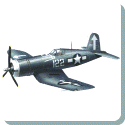 F4U Corsair — The Chance Vought F4U Corsair was a carrier-capable fighter aircraft that saw service primarily in World War II and the Korean War. Demand for the aircraft soon overwhelmed Vought’s manufacturing capability, resulting in production by Goodyear and Brewster: Goodyear-built Corsairs were designated FG and Brewster-built aircraft F3A. From the first prototype delivery to the U.S. Navy in 1940, to final delivery in 1953 to the French, 12,571 F4U Corsairs were manufactured by Vought, in 16 separate models, in the longest production run of any piston-engined fighter in U.S. history (1942–1953).
F4U Corsair — The Chance Vought F4U Corsair was a carrier-capable fighter aircraft that saw service primarily in World War II and the Korean War. Demand for the aircraft soon overwhelmed Vought’s manufacturing capability, resulting in production by Goodyear and Brewster: Goodyear-built Corsairs were designated FG and Brewster-built aircraft F3A. From the first prototype delivery to the U.S. Navy in 1940, to final delivery in 1953 to the French, 12,571 F4U Corsairs were manufactured by Vought, in 16 separate models, in the longest production run of any piston-engined fighter in U.S. history (1942–1953).
The Corsair served in the U.S. Navy, U.S. Marines, Fleet Air Arm and the Royal New Zealand Air Force, as well as the French Navy Aeronavale and other, smaller, air forces until the 1960s. It quickly became the most capable carrier-based fighter-bomber of World War II. Some Japanese pilots regarded it as the most formidable American fighter of World War II, and the U.S. Navy counted an 11:1 kill ratio with the F4U Corsair. As well as being an outstanding fighter, the Corsair proved to be an excellent fighter-bomber, serving almost exclusively in the latter role throughout the Korean War and during the French colonial wars in Indochina and Algeria.
Development
In February 1938, the U.S. Navy Bureau of Aeronautics published two requests for proposal for twin-engined and single-engined fighters. For the single-engined fighter the Navy requested the maximum obtainable speed, and a stalling speed not higher than 70 miles per hour (110 km/h). A range of 1,000 miles (1,600 km) was specified. The fighter had to carry four guns, or three with increased ammunition. Provision had to be made for anti-aircraft bombs to be carried in the wing. These small bombs would, according to thinking in the 1930s, be dropped on enemy aircraft formations.
In June 1938, the U.S. Navy signed a contract for a prototype, the XF4U-1, BuNo 1443. The Corsair was designed by Rex Beisel and the Vought design team. After mock-up inspection in February 1939, construction of the XF4U-1 powered by an XR-2800-4 prototype of the Pratt & Whitney Double Wasp twin-row, 18-cylinder radial engine, rated at 1,805 hp (1,346 kW) went ahead quickly. When the prototype was built it had the biggest and most powerful engine, largest propeller and probably the largest wing on any fighter in history. The first flight of the XF4U-1 was made on 29 May 1940, with Lyman A. Bullard, Jr. at the controls. The maiden flight proceeded normally until a hurried landing was made when the elevator trim tabs failed because of flutter.
On 1 October, the XF4U-1 became the first single-engine U.S. fighter to fly faster than 400 mph (640 km/h) by setting an average ground speed of 405 miles per hour (652 km/h) during a flight from Stratford to Hartford. The XF4U-1 also had an excellent rate of climb but testing revealed that some requirements would have to be rewritten. In full-power dive tests, speeds of up to 550 miles per hour (890 km/h) were achieved but not without damage to the control surfaces and access panels and in one case, an engine failure. The spin recovery standards also had to be relaxed as recovery from the required two-turn spin proved impossible without resorting to an anti-spin chute. The problems clearly meant delays in getting the type into production.
Reports coming back from the war in Europe indicated that an armament of two. 30 in (7.62 mm) (mounted in engine cowling) and two. 50 in (12.7 mm) machine guns (one in each outer wing panel) was insufficient, so when the U.S. Navy asked for production proposals in November 1940, heavier armament was specified.
Formal US Navy acceptance trials for the XF4U-1 began in February 1941. The Navy entered into a letter of intent on 3 March 1941, received Vought’s production proposal on 2 April and awarded Vought a contract for 584 F4U-1 fighters, which were given the name “Corsair”, on 30 June of the same year. The first production F4U-1 performed its initial flight a year later, on 24 June 1942. It was a remarkable achievement for Vought; compared to land-based counterparts, carrier aircraft are “overbuilt” and heavier, to withstand the extreme stress of deck landings.
Design
The F4U incorporated the largest engine available at the time: the 2,000 hp (1,500 kW) 18-cylinder Pratt & Whitney R-2800 Double Wasp radial. To extract as much power as possible, a relatively large Hamilton Standard Hydromatic three-blade propeller of 13 feet 4 inches (4.06 m) was used. To accommodate a folding wing, the designers considered retracting the main landing gear rearward, but for the chord of wing that was chosen, it was difficult to make the landing gear struts long enough to provide sufficient clearance for the large propeller. Their solution was an inverted gull wing, which considerably shortened the required length of the main gear legs. The anhedral of the wing’s center-section also permitted the wing and fuselage to meet at the optimum angle for minimizing drag, without using wing root fairings. Offsetting these benefits, the bent wing was heavier and more difficult to construct.
 Kids Portal For Parents India Kids Network
Kids Portal For Parents India Kids Network
